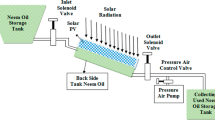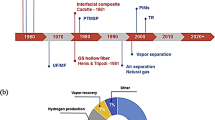Abstract
A nanoporous ceramic membrane tube (CMT) is able to extract water vapor and latent heat from gas mixture, such as flue gas exhausted from thermal power plant, because of its excellent permselectivity and heat-exchange capacity. However, due to the effect of the gravity force on condensation film formation and condensate permeation process, the water and heat-recovery performance on top and bottom parts of a horizontal CMT may be distinct. In this study, a corresponding experiment was performed to verify and research the phenomenon by installing six equidistant and symmetrical measuring points at top and bottom parts of the experimental CMT module, respectively. According to the experimental data, the local temperature of cooling water on top (Tc,l,t) and bottom (Tc,l,b) parts of CMT module exhibited a distinct changing tendency, and the maximum temperature difference (ΔTc) could approach 2.68 °C. Typically, the effects of gravity force on condensation film was negligible, while the permeation capacity of condensate was influenced by gravity force apparently. Moreover, most of condensate (92.24% maximally) was generated during the normal condensation process, merely a small proportion of condensate was produced by the capillary condensation process. This paper is useful for horizontal membrane type gas-water technology improvement.





















Similar content being viewed by others
Abbreviations
- h :
-
Heat transfer coefficient(W/m2.°C)
- T :
-
Temperature(°C)
- d :
-
Inner diameter(m)
- Q :
-
Heat flux(kW)
- U :
-
Velocity(m/s)
- c p :
-
Specific isobaric heat capacity (kJ/kg.°C)
- L :
-
length of ceramic membrane tube(m)
- M :
-
Mass flux (kg/s)
- m :
-
Weight (kg)
- g :
-
Gravity acceleration(m/s2)
- W :
-
Efficiency
- w :
-
Water-recovery rate (kg/m2.h)
- t :
-
Experimental time(s)
- x :
-
x-coordinate (mm)
- all :
-
Overall
- in :
-
Inlet
- out :
-
Outlet
- l :
-
Local
- lat :
-
Latent heat
- sat :
-
Saturated state
- rec :
-
Water recovery
- per :
-
Water permeation
- cap :
-
Capillary condensation
- wall :
-
Wall surface of ceramic membrane tube
- r :
-
Residual condensation liquid film
- n :
-
Normal condensation
- con :
-
Condensation
- f :
-
Feed gas side
- c :
-
Cooling water side
- top :
-
Top part of the module
- bot :
-
Bottom part of the module
- b :
-
Bulk temperature (velocity) of feed gas
- δ :
-
Thickness (mm)
- λ :
-
Thermal conductivity(W/m.°C)
- γ :
-
Latent heat (kJ/kg)
- μ :
-
Dynamic viscosity (Pa.s)
References
Karousos DS et al (2017) Nanoporous ceramic supported ionic liquid membranes for CO2 and SO2 removal from flue gas. Chem Eng J 313:777–790
Wang T et al (2015) Transport membrane condenser for water and heat recovery from gaseous streams: performance evaluation. J Membr Sci 484:10–17
Xu J, Chen Y, Xie J (2018) Non-dimensional numerical study of droplet impacting on heterogeneous hydrophilicity/hydrophobicity surface. Int J Heat Mass Transf 116:951–968
Chua YT et al (2015) Nanoporous organosilica membrane for water desalination: theoretical study on the water transport. J Membr Sci 482:56–66
Vyskocil L, Schmid J, Macek J (2014) CFD simulation of air–steam flow with condensation. Nucl Eng Des 279:147–157
Yang Z, Peng XF, Ye P (2008) Numerical and experimental investigation of two phase flow during boiling in a coiled tube. Int J Heat Mass Transf 51(5–6):1003–1016
Xie J, Xu J, Cheng Y et al (2015) Condensation heat transfer of R245fa in tubes with and without lyophilic porous-membrane-tube insert[J]. Int J Heat Mass Transf 88:261–275
Zhang Y, Faghri A, Shafii MB (2001) Capillary blocking in forced convective condensation in horizontal miniature channels. J Heat Transf 123(3):501
Uchytil P, Loimer T (2014) Large mass flux differences for opposite flow directions of a condensable gas through an asymmetric porous membrane. J Membr Sci 470:451–457
Bao A, Wang D, Lin C (2015) Nanoporous membrane tube condensing heat transfer enhancement study. Int J Heat Mass Transf 84:456–462
Xu J, Xie J, He X et al (2017) Water drop impacts on a single-layer of mesh screen membrane: effect of water hammer pressure and advancing contact angles[J]. Exp Thermal Fluid Sci 82:83–93
Asfand F, Stiriba Y, Bourouis M (2015) CFD simulation to investigate heat and mass transfer processes in a membrane-based absorber for water-LiBr absorption cooling systems. Energy 91:517–530
Le T et al (2016) Numerical study of the migration of a silicone plug inside a capillary tube subjected to an unsteady wall temperature gradient. Int J Heat Mass Transf 97:439–449
Nazarimanesh M, Yousefi T, Ashjaee M (2015) Experimental study on the effects of inclination situation of the sintered heat pipe on its thermal performance. Exp Thermal Fluid Sci 68:625–633
Caruso G, Vitale Di Maio D (2014) Heat and mass transfer analogy applied to condensation in the presence of noncondensable gases inside inclined tubes. Int J Heat Mass Transf 68:401–414
Alammar AA, Al-Dadah RK, Mahmoud SM (2016) Numerical investigation of effect of fill ratio and inclination angle on a thermosiphon heat pipe thermal performance. Appl Therm Eng 108:1055–1065
Behrang A et al (2016) A theoretical study on the permeability of tight media; effects of slippage and condensation. Fuel 181:610–617
Shah MM (1979) A general correlation for heat transfer during film condensation inside pipes[J]. Int J Heat Mass Transf 22(3):547–556
Wang X, Chang H, Corradini M (2016) A CFD study of wave influence on film steam condensation in the presence of non-condensable gas. Nucl Eng Des 305:303–313
Dehbi A, Janasz F, Bell B (2013) Prediction of steam condensation in the presence of noncondensable gases using a CFD-based approach. Nucl Eng Des 258:199–210
Fu W et al (2016) Numerical investigation of convective condensation with the presence of non-condensable gases in a vertical tube. Nucl Eng Des 297:197–207
Yi Q et al (2016) Visualization study of the influence of non-condensable gas on steam condensation heat transfer. Appl Therm Eng 106:13–21
Li J (2013) CFD simulation of water vapour condensation in the presence of non-condensable gas in vertical cylindrical condensers. Int J Heat Mass Transf 57(2):708–721
Lang L, Xin C, Liu X (2018) Heat and mass transfer of liquid nitrogen in coal porous media[J]. Heat Mass Transf 54(2):1–11
Olbricht M, Luke A (2018) Experimental investigation of the heat and mass transfer in a tube bundle absorber of an absorption chiller[J]. Heat Mass Transf
Boyko LD, Kruzhilin G (1967) Heat transfer and hydraulic resistance during condensation of steam in a horizontal tube and bundle of tubes[J]. Int J Heat Mass Transf 10(2):361–373
Chen Q, Xu J, Sun D (2014) The bubble leakage mechanism for vertical upflows by the phase separation concept[J]. Chin Sci Bull 59(21):2638–2646
Funding
This study was funded by the National Key R&D Program of China (grant number 2018YFB0604302).
Author information
Authors and Affiliations
Corresponding author
Ethics declarations
Conflict of interest
The authors declare that they have no conflict of interest. This article does not contain any studies performed by any of the authors. Informed consent was obtained from all individual participants included in the study.
Additional information
Publisher’s note
Springer Nature remains neutral with regard to jurisdictional claims in published maps and institutional affiliations.
Rights and permissions
About this article
Cite this article
Chen, H., Yang, B., Ye, C. et al. Experimental study on differences of heat and mass flux on opposite side of a 10-nm nanoporous ceramic membrane tube. Heat Mass Transfer 56, 219–237 (2020). https://doi.org/10.1007/s00231-019-02711-0
Received:
Accepted:
Published:
Issue Date:
DOI: https://doi.org/10.1007/s00231-019-02711-0




